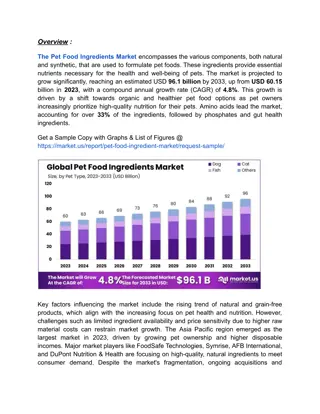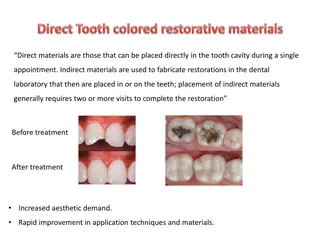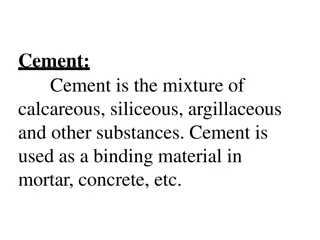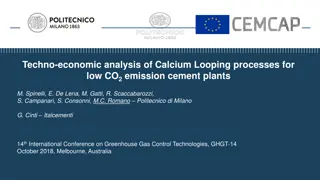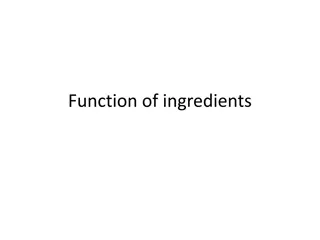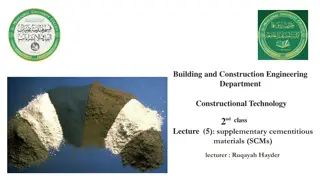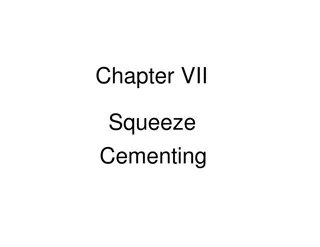Essential Functions of Cement Ingredients
Lime, silica, alumina, magnesia, iron oxide, calcium sulfate, and sulfur trioxide are crucial ingredients in cement production. Each element plays a specific role in the formation, strength, setting time, and overall quality of cement. Understanding the functions and effects of these ingredients is vital for producing high-quality cement products.
Download Presentation

Please find below an Image/Link to download the presentation.
The content on the website is provided AS IS for your information and personal use only. It may not be sold, licensed, or shared on other websites without obtaining consent from the author.If you encounter any issues during the download, it is possible that the publisher has removed the file from their server.
You are allowed to download the files provided on this website for personal or commercial use, subject to the condition that they are used lawfully. All files are the property of their respective owners.
The content on the website is provided AS IS for your information and personal use only. It may not be sold, licensed, or shared on other websites without obtaining consent from the author.
E N D
Presentation Transcript
Functions of Cement Ingredients The main features of these cement ingredients along with their functions and usefulness or harmfulness are given below:
1. Lime: Lime is calcium oxide or calcium hydroxide. The presence of lime in a sufficient quantity is required to form silicates and aluminates of calcium. Deficiency in lime reduces the strength of property to the cement. Deficiency in lime causes the cement to set quickly. Excess lime makes cement unsound. The excessive presence of lime causes the cement to expand and disintegrate.
2. Silica: Silicon dioxide is known as silica, chemical formula SiO2.The sufficient quantity of silica should be present in cement to dicalcium and tricalcium silicate. Silica imparts strength to cement. Silica usually presents to the extent of about 30 percent cement.
3. Alumina: Alumina isAluminium oxide. The chemical formula is Al2O3. Alumina imparts quick setting property to the cement. Clinkering temperature is lowered by the presence of the requisite quantity of alumina. Excess alumina weakens the cement
4. Magnesia: Magnesium Oxide. The chemical formula is MgO. Magnesia should not be present more than 2% in cement. Excess magnesia will reduce the strength of the cement.
5. Iron oxide: Chemical formula is Fe2O3.Iron oxide imparts color to cement. It acts as a flux. At a very high temperature, it imparts into the chemical reaction with calcium and aluminum to form tricalcium alumino-ferrite. Tricalcium alumino-ferrite imparts hardness and strength to cement. Iron oxide: Chemical formula is Fe2O3.Iron oxide imparts color to cement. It acts as a flux. At a very high temperature, it imparts into the chemical reaction with calcium and aluminum to form tricalcium alumino-ferrite. Tricalcium alumino-ferrite imparts hardness and strength to cement.
6. Calcium Sulfate: Chemical formula is CaSO4This is present in cement in the form of gypsum(CaSO4.2H2O) It slows down or retards the setting action of cement
7. Sulfur Trioxide: Chemical formula is SO3 It should not be present for more than 2%. Excess Sulfur Trioxide causes the cement to unsound.
8. Alkaline: It should not be present more than 1%. Excess Alkaline matter causes efflorescence.
Analysis of Cement Traditionally, cement analysis was carried out using wet-chemical techniques. Now, the days of flasks bubbling away over bunsen burners in the laboratory of a cement works are largely gone, replaced by X-ray analysis equipment of various types. At a cement works (=plant, factory, production facility) raw materials, clinker and cement are analysed using X-ray fluorescence (XRF) and, often, X-ray diffraction (XRD).









